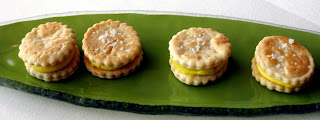This is why Adam, who tends to be more Hoover than man, and I, the shameful owner of a vehicle that often smells of frialator, spent a languid afternoon partaking in what turned out to be a four-hour lunch.
While watching the sky fill with slowly rolling clouds, we relaxed with a flow of twelve courses from the progressive PolytechnicON20 kitchen. Not only was each dish a masterpiece of sight and taste, but our epic mid-day meal also afforded us the opportunity to learn about another part of the world where leisurely dinning is a way of life.
The region of Piedmont in northwestern Italy, a stretch of picturesque lakes and rolling hills surrounded on three sides by the Alps, is not only a gourmand mecca famous for austere wines and prized wild truffles, but it is also the origin of the Slow Food movement, a response to the fast food revolution dedicated to preserving the tradition of handmade, artisanal cuisine.
A typical Piedmontese meal spans anywhere from three to six courses and is a time for sharing the company of family and friends as well as for sustenance.
One of the talented chefs and creative minds in the ON20 kitchen, Lucas Maylott, lived and worked for over two years in the area of Alba, Piedmont. Originally visiting the region as a backpacker in 2002, Maylott was introduced to the head chef of the famous Trattoria del Castello Grinzane Cavour and invited to work a five-month stage.
A hilltop castle built in 1012, Castello Cavour is the region’s most well-known restaurant and the host of the annual World Truffle Auction. The auction draws many illustrious chefs and coincides with the yearly truffle fair in Alba, which celebrates the peak season of these indigenous “diamonds of the kitchen.”
During his stage, Maylott cooked for the auction where the largest white truffle that year was sold to the Ritz Carlton in Hong Kong for $120,000.
In 2007, Maylott returned to Piedmont to the restaurant Cascina Langa, a historic farmhouse with a 180-degree view of the Alps, where he worked until 2009.
The food prepared and celebrated in Piedmont is not the same as the Italian cuisine that most Americans are familiar with, which is generally from the southern part of the country, says Maylott. The flavors of Piedmont carry influences from neighboring France and the region itself is famous for the country’s most tradition-bound cooking.
During our relaxing luncheon at ON20, we were treated to a typical Piedmont recipe, rabbit angolotti del plin. A favorite pasta of Maylott, angolotti are usually made each Sunday by Piedmontese grandmothers and filled with leftover meat and vegetables from throughout the week.

Served in a sauce of white wine, herbs and carrots, the rich and delicate angolotti was a dish Maylott says he made often while overseas. He also maintains that he uses the “best” method for making farce, or the angolotti filling, in which he uses braised vegetables instead of cheese as a binding agent.
Another distinctive dish of Piedmont is carne cruda, chopped raw Fassone beef drizzled with olive oil, lemon and salt. Fassone beef is native to northern Italy and is prized for being extremely lean, a characteristic that has led to the preference for consuming the meat raw. Carne cruda is often enjoyed twice a day by the Piedmontese, says Maylott.
Tajarin, thin hand-cut pasta similar to tagliatelle, is also popular as well as vitello tonnato, fine-sliced roasted veal topped with a tuna, caper and mayo sauce that Maylott would love to see served as a sandwich.
Such modifications to convention are not always welcomed in Piedmont, however, where Maylott explains that every restaurant has virtually the same menu and traditions are deeply rooted.
Back in the ON20 kitchen, on the other hand, bending the rules in search of innovative creations is a mainstay.
Executive Chef Noel Jones, Chef de Cuisine Jeffery Lizotte and Chef Maylott each day offer guests fresh ingredients, meticulously prepared in new and dazzling ways, such as beet caviar or mushroom “scaled” flounder.
With a blend of styles, methods and influences mixed with a level of professionalism rarely seen, ON20 easily offers best lunch in Connecticut, one you’ll wish will never end.
Continue reading here for more about the techniques utilized in the ON20 kitchen.
And here it is, the Food Porn:
 Trio of ice cream sandwiches. Meyer lemon profiterole, eskimo bar with caramel and chocolate ginger.
Trio of ice cream sandwiches. Meyer lemon profiterole, eskimo bar with caramel and chocolate ginger.














No comments:
Post a Comment